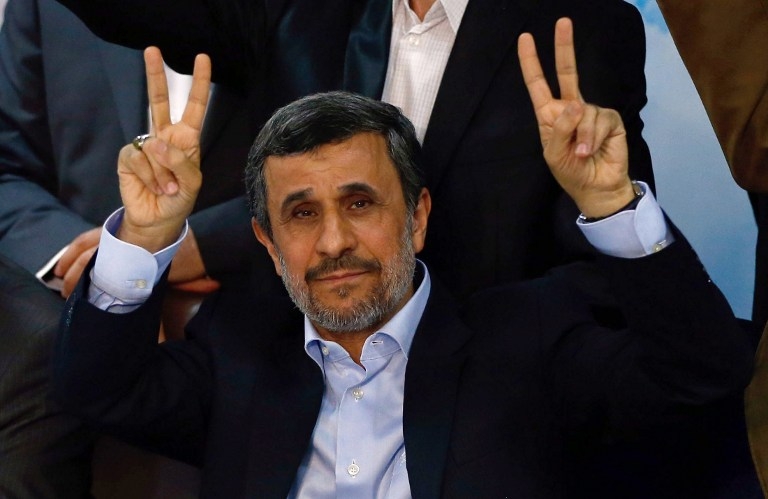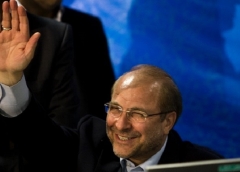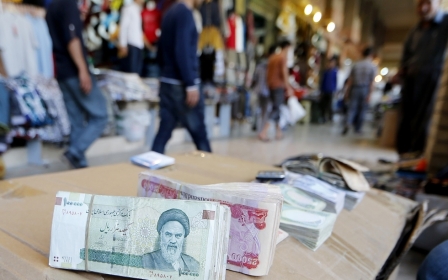Iran elects: Ahmadinejad may be disqualified, but his influence has staying power

What was expected to be a fairly sanitised presidential elections in Iran was dramatically disrupted this week by Mahmoud Ahmadinejad.
The former president's decision to enter the race is a direct rebuke to the leader, Ayatollah Seyed Ali Khamenei, who last September advised him not to run in the elections scheduled for 19 May.
Ahmadinejad is trying to stake out a political future as a third force in Iranian politics
His move has been widely interpreted as a political gimmick designed to contrive drama rather than a serious quest to run and, despite his eight-year presidential record, Ahmadinejad is unlikely to get the approval of the Council of Guardians all candidates must have under law to run.
But in the unlikely event that he gets the green light, the combative Ahmadinejad will radicalise positions on all sides and pose a credible threat to the incumbent Hassan Rouhani.
Systemic weakness
Ahmadinejad’s dramatic entry into the race speaks to the wider weaknesses of the Iranian electoral system.
While campaigning methods get more sophisticated with every election cycle, the underlying system hinders a more disciplined approach toward candidacy.
In fact, in the absence of strong and established parties, the initial phase of the elections, namely candidacy registration which began this Tuesday and is set to close on Saturday, is marked by a degree of randomness and, in some cases, total absurdity.
This chaotic system naturally suits political agitators like Ahmadinejad, who is set on provoking the establishment. More broadly, it appeals to an electorate with a proclivity to produce surprises at the polls.
Iran’s idiosyncratic electoral system is more a natural by-product of the country’s political culture than a carefully crafted mechanism. Indeed, there are no insurmountable institutional obstacles stopping people from forming strong political organisations.
Yet existing political parties are invariably weak with ill-defined procedures and hierarchies and little connection to the grassroots they are meant to represent. Instead, makeshift movements emerge in every electoral cycle to galvanise the supporters on either side of the country’s main political divide, namely that of reformists and conservatives.
Provoking the establishment
Into this chaotic mix enters Ahmadinejad. The former president was long expected to make a splash in the elections, although not directly: few thought he would dare disobey Ayatollah Khamenei. Many thought he would simply stir the pot through his protégé Hamid Baghaei, who has also registered his candidacy.
Sure enough, after he entered the race this week, Ahmadinejad said that he did it merely to support Baghaei, a claim that is lent credence by joint campaigning, most recently among the influential Bakhtiari tribes of southwestern Iran.
It is noteworthy that Ahmadinejad’s controversial right-hand man, Esfandiar Rahim Mashaei, nearly always appears with the two candidates in public, giving the impression that they are running an organised electoral movement with staying power.
In view of the establishment’s disdain for these men, who are regarded as a “deviant current”, it is unlikely that even Baghaei will be cleared by the Council of Guardians.
So the key question at this juncture is what Ahmadinejad and his inner circle hope to gain by provoking the establishment. Their motives are likely to be many and it is worth mentioning that Ahmadinejad has a strong social constituency, meaning there is a clear political demand for his continued presence on the national scene to balance out other political forces.
The election field
The wider electoral picture provides further clues as to Ahmadinejad’s motivation. In keeping with a tradition dating back to 1981, the incumbent President Rouhani, a centrist, is widely expected to secure a second term.
So far, the strongest credible challenger is Ebrahim Raisi, the custodian of the Imam Reza shrine in Mashhad and, by extension, the vast business empire attached to it. A close ally of the leader Ayatollah Khamenei, not so long ago Raisi was being touted as his potential successor.
The conservatives haven’t held the presidency since 1989, in part because of internal divisions and an inability to rally round a consensual candidate, and it remains to be seen if Raisi can form a solid conservative consensus in the run-up to the polls.
Ghalibaf has yet to register for the race, but it is expected that he will do so shortly. In the last presidential race in June 2013, he came a distant second with just over 16 percent of the vote and is unlikely to perform any better this time round.
Entirely disowned by the conservative establishment, Ahmadinejad and his inner circle can best be described as maverick principlists. The principlist (Osoolgera in Farsi) current in the Islamic Republic is widely considered to be an extension of the conservatives, despite important political and attitudinal differences between the two.
More of a principlist than a conservative stalwart, Ebrahim Raisi is considered to be a cross-pollination candidate of sorts. Indeed, the impromptu political organisation that he represents, namely the Popular Front of Islamic Revolution Forces formed late last year, speaks more to radical principlist attitudes than conservatism.
At a national level, the conservatives/principlists face off against a broad - but relatively cohesive - reformist and centrist coalition. This divide has been the defining feature of Iranian politics since 1997, with Ahmadinejad’s presidency (2005-2013), especially his second term, considered an aberration.
Ahmadinejad is trying to stake out a political future as a third force in Iranian politics. He represents a principlist movement that is distinctly different from other conservative and even other principlist factions. Even, as is expected, he and Baghaei are disqualified from this year’s race, Ahmadinejad hopes to build a credible platform to contest future elections.
It remains to be seen to what extent, if any, the Iranian establishment can co-opt this insurgent movement.
- Mahan Abedin is an analyst of Iranian politics. He is the director of the research group Dysart Consulting.
The views expressed in this article belong to the author and do not necessarily reflect the editorial policy of Middle East Eye.
Photo: Former Iranian president Mahmoud Ahmadinejad (C) flashes the sign for victory at the interior ministry's election headquarters as candidates begin to sign up for the upcoming presidential elections in Tehran on April 12, 2017.
This article is available in French on Middle East Eye French edition.
Middle East Eye propose une couverture et une analyse indépendantes et incomparables du Moyen-Orient, de l’Afrique du Nord et d’autres régions du monde. Pour en savoir plus sur la reprise de ce contenu et les frais qui s’appliquent, veuillez remplir ce formulaire [en anglais]. Pour en savoir plus sur MEE, cliquez ici [en anglais].









